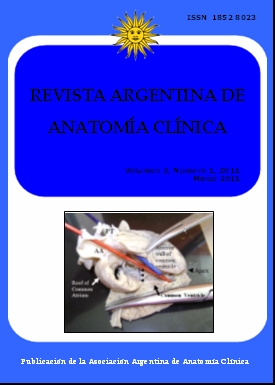LOCATIONS AND LENGTHS OF OSTEOPHYTES IN THE CERVICAL VERTEBRAE. LOCALIZACIONES Y LONGITUD DE LOS OSTEOFITOS EN LAS VÉRTEBRAS CERVICALES
DOI:
https://doi.org/10.31051/1852.8023.v3.n1.13908Keywords:
osteofito, espondilosis cervical, disfagia, braquialgia, vértigo, osteophyte, cervical spondylosis, dysphagia, brachialgia, vertigoAbstract
Muchos pacientes sufren de disfagia, vértigo, dolor en el brazo, entumecimiento o debilidad. Estos problemas pueden ser debidos a la aparición de osteofitos en las vértebras cervicales. El propósito de esta investigación ha sido estudiar las localizaciones y tamaño de los osteofitos en las vértebras cervicales. Se han usado 200 columnas cervicales (139 varones y 61 mujeres) de vértebras secas C3-C7, de un promedio de edad de 71 años (36-98 años). Se han encontrado osteofitos en 184 columnas (92 %), la mayoría en C5, C6, C4, C7 y C3 (83, 77, 74, 65 y 64%, respectivamente). La media del tamaño de los osteofitos en C3 (4.44 ±1.31 mm) ha sido mayor que los de C4-C7. La mayor cantidad de osteofitos se encontraron en los cuerpos vertebrales, carilla articular y foramen transverso (49,35 y 16%) respectivamente. La mayor longitud de los osteofitos en el cuerpo de las vértebras se encontraron en la vértebra fue 4.28 ±1.65 mmen C6, en la cara articular fue 5.07 ±1.57 mmen C5 y en el transverso foramen fue 2.49 ±1.57 mmen C6. La longitud de los osteofitos del lado anterior superior y de la cara inferior del cuerpo ha sido más larga que la de los lados posterior y lateral. La longitud de los osteofitos muestra una correlación significativa y directa con la edad. Conclusión: Los osteofitos que han aparecido en el cuerpo de las vértebras, la cara y el foramen transverso pueden incidir en las estructuras cercanas. Este estudio puede ayudar a explicar algunos problemas clínicos como la disfagia, insuficiencia vertebrobasilar y braquialgia.
Many patients suffer from dysphagia, vertigo, arm pain, numbness or weakness. These problems may arise from osteophytes in the cervical vertebrae. The purpose was to study the distribution and lengths of osteophyte in the cervical vertebrae. We used 200 cervical columns (139 male and 61 female) of dry C3-C7 vertebrae. Osteophytes were found in 184 columns (92%), mostly at C5, C6, C4, C7 and C3 (83, 77, 74, 65 and 64% respectively) . The average length of osteophytes of C3 (4.44 ± 1.31 mm) was longer than those of C4-C7. The quantity of osteophytes mostly was found at vertebral bodies, articular facets and transverse foramen (49, 35 and 16%) respectively. The greatest osteophyte length of vertebral bodies was at C6 (4.28 ± 1.65 mm.), that of articular facet was at C5 (5.07 ± 1.57 mm.) and that of foramen transversarium was at C6 (2.49 ± 1.57 mm.). The osteophyte length of anterior area of superior and inferior surface of body was longer than posterior and lateral area. The osteophyte length was significantly correlated with age. Conclusion: The osteophytes that occurred at vertebral bodies, facet and transverse foramen may impinge on nearby structures. This study may help in explaining some clinical problems such as dysphagia, vertebrobasilar insufficiency and brachialgia.
References
Bayrak IK, Durmus D, Bayrak AO, Diren B, Canturk F. 2009. Effect of cervical spondylosis on vertebral arterial flow and its association with vertigo. Clin Rheumatol 28: 59-64.
Borenstein DG, Wiesel SW, Boden SD. 2004. Anatomy and Mechanics of the Cervical and Lumbar Spine. Low Back and Neck Pain. 3rd Edition. Philadelphia: Saunders: The McGraw-Hill companies.
Bulsara KR, Velez DA, Villavicencio A. 2006. Rotational vertebral artery insufficiency resulting from cervical spondylosis. Surg Neurol 65: 625-627.
Constantoyannis C, Papadas T, Konstantinou D. 2008. Diffuse idiopathic skeletal hyperostosis as a cause of progressive dysphagia: a case report.Cases J 23: 416.
Ebraheim NA, An HS, Xu R, Ahmad M, Yeasting R. 1996. The quantitative anatomy of the cervical nerve root groove and the intervertebral foramen. Spine 21: 1619-1623.
Harrop JS, Hanna A, Silva MT, Sharan A. 2007. Neurological manifestation of cervical spondylosis: an overview of signs, symptoms and pathophysiology. Neurosurgery 60: S14-20.
Klaassen Z, Tubbs RS, Apaydin N, Hage R, Jordan R, Loukas M. 2010. Vertebral spinal osteophytes. Anat Sci Int. Apr 10. URL:http://www.ncbi.nlm.nih.gov/pubmed/20383671 (accessed May2010).
Maiuri F, Stella L, Sardo L, Buonamassa S. 2002. Dysphagia and dyspnea due to an anterior cervical osteophyte. Arch Orthop Trauma Surg 122: 245-247.
Oppenlander ME, Orringer DA, La Marca F., McGillicuddy JE, Sullivan SE, Chandler WF, Park P. 2009. Dysphagia due to anterior cervical hyperosteophytosis. Surg Neurol 13: 266-70.
SeidlerTO, Pérez Alvarez JC, Wonneberger K, Hacki T. 2009. Dysphagia caused by ventral osteophytes of the cervical spine: clinical and radiographic findings. Eur Arch Otorhino-laryngol 266: 285-291.
Shedid D, Benzel EC. 2007. Cervical spondylosis anatomy: pathophyology and biomachanics. Neurosurgery 60: S7-13.
Solaroglu I, Okutan O, Karakus M, Saygili B, Beskonakli E. 2008. Dysphagia due to diffuse idiopathic skeletal hyperostosis of the cervical spine. Turk Neurosurg 18: 409-411.
Takeuchi S, Kawaguchi T, Nakatani M, Isu T. 2009. Hemorrhagic infarction originating from vertebral artery stenosis caused by an osteophyte at the C5 superior articular process. Neurol Med Chir (Tokyo) 49: 114-116.
Tsutsumi S, Ito M, Yasumoto Y. 2008. Simultaneous bilateral vertebral artery occlusion in the lower cervical spine manifesting as bow hunter's syndrome. Neurol Med Chir (Tokyo); 48: 90-94.
White BD, Buxton N, Fitzgerald JJ. 2007. Anterior cervical foraminotomy for cervical radiculop-athy. Br J Neurosurg 21: 370-74.
Zhao L,XuR, HuT,MaW,Xia H, Wang G. 2008. Quantitative evaluation of the location of the vertebral artery in relation to the transverse foramen in the lower cervical spine. Spine 33: 373-378.
Downloads
Published
Issue
Section
License
Authors retain copyright and grant the journal right of first publication with the work simultaneously licensed under a Creative Commons Attribution License that allows others to share the work with an acknowledgement of the work's authorship and initial publication in this journal. Use restricted to non commercial purposes.
Once the manuscript has been accepted for publications, authors will sign a Copyright Transfer Agreement to let the “Asociación Argentina de Anatomía Clínica” (Argentine Association of Clinical Anatomy) to edit, publish and disseminate the contribution.



